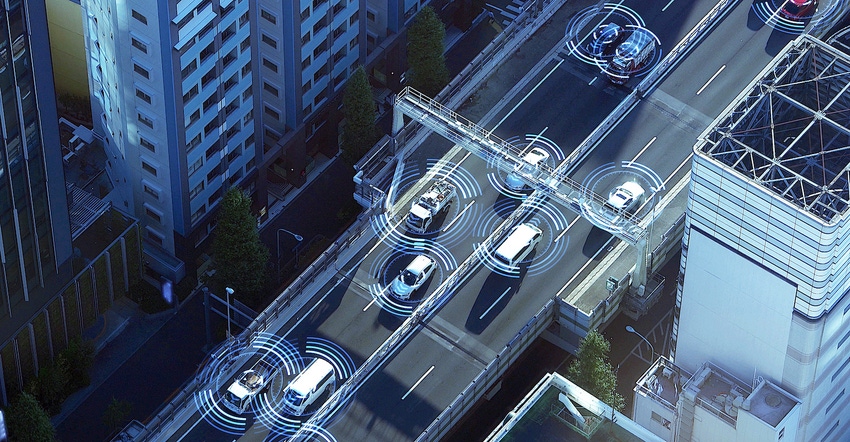AAA: ADAS Could Prevent 37 Million Crashes over 30 Years
Technology can save lives, but shortcomings lead AAA to promote a holistic solution for comprehensive safety.

Modern automotive driver assistance systems are poised to prevent 37 million crashes, 14 million injuries, and nearly a quarter-million deaths by 2050.
That’s the forecast released by the American Automobile Association (AAA). The AAA Foundation for Traffic Safety commissioned University of North Carolina researchers to investigate the benefits of Advanced Driver Assistance Systems (ADAS) on traffic crashes and fatality over the span of 2021-2050.
These reductions represent 16 percent of crashes and injuries and 22 percent of the deaths that would otherwise occur on U.S. roads without these technologies, AAA concluded.
To estimate future safety benefits, the researchers forecasted crashes, injuries, and deaths expected in future years before accounting for the effects of ADAS by assuming that future crashes would be similar to crashes that occurred in 2017–2019 plus an annual increase due to increasing vehicle travel. The researchers then estimated the probability that ADAS would prevent each future crash.
What is ADAS?
While consumers await fully automated vehicles in the increasingly distant future, ADAS serves to help human driver minimize their mistakes. These assistance systems include:
Adaptive Cruise Control: Cruise control that also assists with acceleration and braking to maintain a driver-selected gap to the vehicle in front. Some systems can come to a stop and continue, while others cannot.
Automatic Emergency Braking: Detects potential collisions with a vehicle ahead, provides forward collision warning, and automatically brakes to avoid a collision or lessen the severity of impact. Some systems also detect pedestrians or other objects.
Lane Departure Warning: Monitors the vehicle’s position within the driving lane and alerts the driver as the vehicle approaches or crosses lane markers.
Lane Keeping Assistance: Provides steering support to assist the driver in keeping the vehicle in the lane. The system reacts only when the vehicle approaches or crosses a lane line or road edge.
Blind Spot Monitoring: Detects vehicles in the blind spot while driving and notifies the driver of their presence. Some systems provide an additional warning if the driver activates the turn signal.
Clearing the Confusion
Unfortunately, automakers insist on applying their own trademarked names to their versions of these systems, leading to confusion among drivers. That’s why the AAA is calling for standardization of these names.
The proposed “Clearing the Confusion” effort started in 2019 with an initial list of standardized names and was endorsed by the U.S. Department of Transportation in 2020. AAA says these recommended terms are simple, specific, and based on system functionality.
“The future for ADAS is bright, but it’s not a cure-all,” said Jake Nelson, AAA’s director of traffic safety advocacy. “While these technologies offer substantial safety benefits, we cannot engineer our way out of traffic injuries and deaths on U.S. roads. Investments in a diversity of proven traffic safety measures, including but not limited to vehicle technology, is in order.”
Previous AAA reports have found that automatic emergency braking systems are ineffective at highway speeds, that the collision avoidance systems work poorly protecting pedestrians and cyclists, and that ADAS performance is significantly degraded by rain.
Safe System Approach
Because of these issues, AAA’s Foundation for Traffic Safety is advocating for a holistic approach to safety that doesn’t just rely on technology in cars to prevent crashes, injuries, and fatalities. Instead, the Foundation supports the Safe System Approach (SSA), which has six key tenants:
Expect Human Error. To be human is to be imperfect, so we must assume that humans will make mistakes that can lead to traffic crashes (e.g., speeding, driving impaired, run-off-the-road, etc.). Therefore, we develop a transportation system that expects it to happen.
Be Proactive. Good data allows us to identify the factors contributing to crashes within the system, where they occur, and the people involved in them. Use these data to proactively shape the system to prevent these crashes from occurring with a focus on the most vulnerable people (i.e., those people most likely to be injured or killed in a crash).
Vulnerable Populations. Pedestrians, bicyclists, and older road users are some of the most vulnerable users of the transportation system. We can build the system to be more forgiving to these populations so that if they are involved in a crash the odds of serious injury or death are minimized (e.g., separate motor vehicle traffic from pedestrian and bicycle traffic).
Redundancy is Critical. Work to ensure the safety countermeasures in place within the travel environment (i.e., the system) create redundancy or layers of protection for people traveling within it. If one fails, there should be others at the ready to offer protection. Each set of countermeasures reduces the risk of serious injury and death.
Make Zero Traffic Deaths the Goal. This has less to do with how realistic it might be to achieve zero deaths on our roads, and more to do with the direction and focus that guides decision-making when spending money, enacting laws, breaking ground on infrastructure projects, or enhancing the design of new vehicles.
Responsibility is Shared. Turning things around in the U.S. is a great responsibility that should be shouldered by all of us. This is a significant public health challenge that cannot be solved by any level of government, or just automakers, for example. All stakeholders (including individual users of the transportation system) have a role to play. The total effect is what will turn the tide on traffic deaths in the U.S. Specifically, the SSA includes the following elements: Safe Vehicles, Safe Roads, Safe Road Users, Safe Speeds, and Post-Crash Care.
About the Author(s)
You May Also Like





